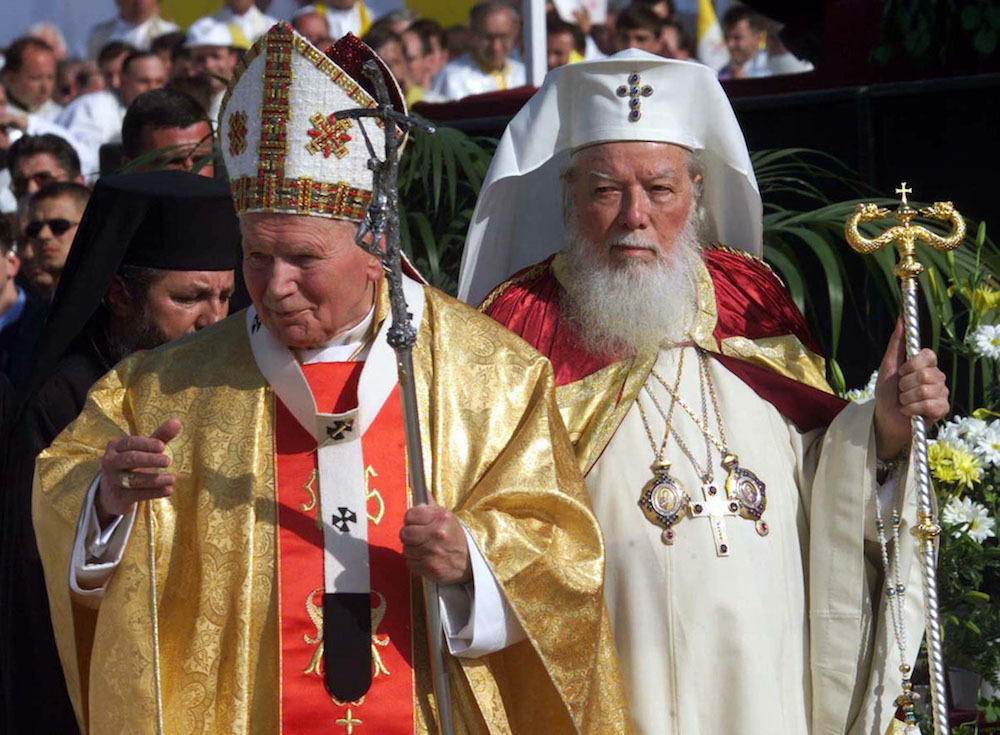Twenty years after Pope John Paul II’s historic visit, Pope Francis will visit Romania, the “garden of the Virgin Mary,” from May 31 to June 2, to build upon the foundations laid down by his predecessor.
While some underlining themes remain the same as 1999, such as relations with the Orthodox Church and local Marian devotions, others are completely new with the trip providing unique opportunities for the pope to spread a message of welcoming and integration to a post-elections European Union.
“I come to you to walk together,” Francis said in a May 28 message to the people of Romania, referencing the motto of the papal visit “Walking Together.”
“We walk together when we learn to keep the roots of the family, when we cater to the future of our children and of our brothers next to us, when we go beyond fear and suspicion, when we let the walls that divide us from others fall,” he said.
Romania is the “most religious country in Europe,” a 2018 Pew Research Study found. The Orthodox church represents the majority (over 80 percent of the population), followed by Protestants (6.2 percent) and Roman and Greek Catholics (5.1 percent), according to a 2011 census.
From 1947 to 1989, Romania was under a Marxist-Leninist one-party communist rule, which deeply impacted its multifaceted religious life. In 1948, the regime forced the local Greek Catholics to merge with the Orthodox majority and confiscated their property. This moment created deep wounds that still today tarnish Catholic-Orthodox relations in the country.
“I think we can say, with no offence or exaggeration, that the climate is a bit tense, so definitely the visit of the Holy Father is very important for Greek Catholic and Orthodox relations,” said Romanian Father Gergely Kovács, head office at the Pontifical Council for Culture, in a May 28 interview with Crux.
On May 31, Francis will have a private meeting with Romanian Orthodox Patriarch Daniel at the patriarchal palace, followed by a meeting with members of the permanent Orthodox synod. The pope will pray the “Our Father” with them and then celebrate Mass at the Catholic Cathedral of St. Joseph.
When John Paul II visited Romania, he was the first pontiff to visit this Orthodox majority country after the schism of 1054 that separated Catholics from Orthodox. On the trip, he was only able to visit the capital city of Bucharest to mend relations with the Orthodox community, which he described as the other “lung of Europe.”
This time Francis will be able to visit not only Bucharest, to meet with diplomatic, political and religious authorities, but also Moldavia and Transylvania, two regions where Greek and Roman Catholics flourish.
Francis will beatify seven martyred bishops of the Greek Catholic Church at Blaj’s Liberty Field in Transylvania. This will send an important message of unity and support for the Catholics of Romania, in the same spot where the communist national assembly planned the elimination of Greek Catholics.
“If we take as a starting point the papal visit 20 years ago, I hope and wish that this is the continuation, and that the first stones that were laid down slowly become a walking together,” Kovács said.
There will be an important moment to connect with Latin Rite Catholics - mostly Hungarian - at the Marian shrine of Sumuleu Ciuc. This important pilgrimage site is a preferred destination for many Catholics in Hungary. The Vatican announced May 29 that over 110,000 people have already registered, with a chance that those numbers could double or triple.
Here, Francis will have a chance to bring the customary golden rose - given by popes to major Marian shrines - to the large wooden replica of the Madonna, but he will also have the opportunity to send a message to the many Catholic Hungarians there to keep their hearts, minds and gates open to others.
Hungary has taken a right-wing populist turn after the election of its Prime Minister, Viktor Orbán, who has led the country with a nationalist and anti-immigration agenda. While Orbán will not be at the shrine, the Hungarian President János Áder and many Hungarian bishops have already confirmed their participation.
The pope’s words at the holy grounds of Sumuleu Ciuc may have an impact not only on Catholics in Romania, but also their Hungarian neighbors just as Europe closes its EU Parliament elections that saw populists make significant gains.
“While the theme and the dimension of the trip is pastoral and ecumenical, it will take this aspect into account,” said Vatican spokesman Alessandro Gisotti during a May 29 meeting with Vatican journalists, pointing out that Romania also currently presides over the European Commission.
“I think some speeches could also be read in this European context,” he added. “Certainly, the Holy Father has in mind the multiethnic dimension and the many Romanians who emigrated to many countries in Europe.”
The visit, Gisotti said, “is for Romania, but not just for Romania” taking into account “the strong Hungarian presence at the sanctuary.”
Over four million Romanians have left their homeland for Spain, Italy, Germany and other EU countries in search of better living conditions after the devastation and poverty caused by the communist regime. Now, Romania has one of the highest economic growth rates in Europe and eager, young emigrant workers could provide a benefit by returning home.
“Now there is an economic growth and we need people to work,” said Liviu - Petru ZƒÉpîr≈£an, Romanian Ambassador to the Holy See, in a May 24 interview with Crux.
